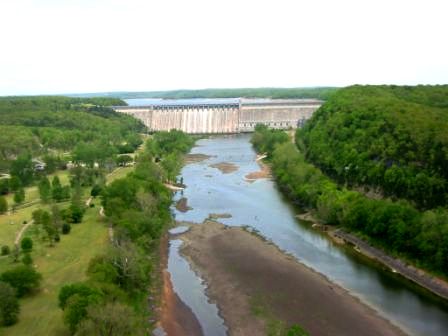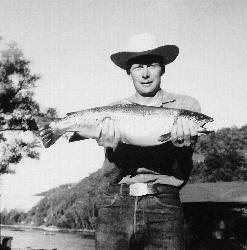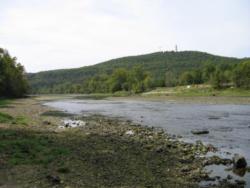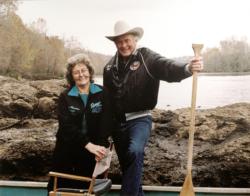Back Story: Forrest L. Wood’s river quest

It was a question posed by a man whose familiarity with the White River country compelled him to ask it: Why can’t minimum flowage be maintained in the river below Bull Shoals Dam?
When Forrest Wood asked that question of Arkansas Game and Fish Commission (AGFC) staffers more than 14 years ago, the only response they could give him was that they were all for it, but minimum flowage was a complicated project. As a determined Wood found out for himself when he embarked on a mission to guarantee minimum flow in the White, the Commission foot soldiers had it right. That didn’t keep him from persisting in his efforts, however, and this year in mid January his long quest came to a successful conclusion.
Beginning in 2013, or after AGFC has moved Bull Shoals Lake shoreline facilities and roads as necessary, constant minimum flow below its dam will be maintained. The water in Bull Shoals will rise by about 3 feet and stay there to act as a reservoir that ensures minimum flowage. Where before, when the hydroelectric generators were closed and leakage allowed for a maximum flow of about 500 cubic feet per second below the dam, the flowage won’t be less than 800 cubic feet per second.
“This is going to do three very important things,” says Wood, who was appointed to a seven-year stretch in 1998 on the Commission by then-governor Mike Huckabee. “First, it’s going to increase and maintain the food-producing habitat for trout considerably. It’s also going to keep the water colder in hot weather farther downstream and make trout-friendly water longer and wider, which is good for the trout and their forage base. And year-round navigation will be ensured for boaters and fishermen. It’s going to have tremendous benefits for the river and the communities along its banks.”
The project to ensure minimum flowage downstream from Bull Shoals Dam is a case study in how the system is supposed to work when a determined effort makes its way up through the halls of the mighty in Washington, D.C. As the last century came to a close, Wood and the commission started the proceedings by first making a trip to D.C. to visit congressmen and senators, explaining that everything depended on their ability to gain approval and funding for various studies that involved federal agencies.
Completed in 1957, the Bull Shoals Dam essentially was built to do two things: dump flood water from upstream and generate hydroelectric power. Recreational fishing wasn’t part of the program; minimum flowage didn’t exist as far as the dam’s manager, Southwestern Power Administration, was concerned. Either the water was flowing through the dam to generate electricity, or to relieve flooding upstream, or it wasn’t.
Long ago, the AGFC came up with the idea to stock trout in the river, because the water that flowed from the deep channel of Bull Shoals Lake was just right most of the time for the coldwater fish and the habitat on which they depended. Stocked trout grew an average of an inch a month in the river. Within a few years after the stocking program began, the White River became one of the best trout fisheries in the country. Guide services sprang up and resorts flourished.
One nagging problem always remained, however, and manifested itself during the hottest days of summer. When the dam wasn’t generating and the rocks and gravel that line the bottom of the water-starved river started baking under the Arkansas sun, bad things happened. The insect life and minnows that trout depend on died, and even the trout were susceptible to heat stress that was often fatal. Guide boats were confined to stretches between rocky shoals that couldn’t be traversed, and the river generally shut down.
 Once Wood got behind the idea of guaranteeing minimum flowage and learned of the ways and means to ensure it, his first points of contact were politicians such as Asa Hutchinson, a U.S. Congressman, and his brother Tim Hutchinson, a U.S. Senator. Gradually, as elected backers came and went, others picked up where some left off. U.S. Congressman John Bozeman, a Congressman at the time who is now a U.S. Senator, worked on it, as did former U.S. Congressman Marion Berry of eastern Arkansas, who helped the project across the finish line. At the state level, AGFC Fisheries Chief Mike Armstrong was the project leader and provided coordination, technical reviews and any work required of the state. He stayed on point throughout the process and kept open all the lines of communication.
Once Wood got behind the idea of guaranteeing minimum flowage and learned of the ways and means to ensure it, his first points of contact were politicians such as Asa Hutchinson, a U.S. Congressman, and his brother Tim Hutchinson, a U.S. Senator. Gradually, as elected backers came and went, others picked up where some left off. U.S. Congressman John Bozeman, a Congressman at the time who is now a U.S. Senator, worked on it, as did former U.S. Congressman Marion Berry of eastern Arkansas, who helped the project across the finish line. At the state level, AGFC Fisheries Chief Mike Armstrong was the project leader and provided coordination, technical reviews and any work required of the state. He stayed on point throughout the process and kept open all the lines of communication.
“We had been working with the local district corp of engineers to implement minimum flow for a long time, but we never got much traction until Forrest got involved and was able to bring to bear some congressional action,” says Armstrong. “The basic problem was that the enabling federal legislation that caused the dam to be built outlined exactly what the dam was intended to do, how it was to be operated and who had final say-so. You wouldn’t believe the red tape we had to go through to make any changes.”
 Thanks to an Arkansas’ legislative delegation, The Water Resource Development Act of 1999 – in which Congress gave instructions to the Army Corps of Engineers regarding how to spend its appropriations – authorized the reallocation of storage behind the Bull Shoals Dam for the purpose of maintaining a minimum flowage. The same law also authorized the corps to study the feasibility of minimum flowage.
Thanks to an Arkansas’ legislative delegation, The Water Resource Development Act of 1999 – in which Congress gave instructions to the Army Corps of Engineers regarding how to spend its appropriations – authorized the reallocation of storage behind the Bull Shoals Dam for the purpose of maintaining a minimum flowage. The same law also authorized the corps to study the feasibility of minimum flowage.
“The Army Corps of Engineers had to do a lot of studying on it, and Southwestern Power didn’t see the point of it,” says Wood. “So a lot of people had to keep it going: our elected officials in the state and in Washington, the Commissioners that followed me, and many others at the local level.”
In 2004, the Corps study concluded that minimum flowage was an achievable goal, and in fact deemed the project to be technically sound, environmentally acceptable and economically justified. Two years later, Congress authorized the expenditure of funds to implement minimum flowage and added the money in an appropriations bill. A couple of things happened between then and now. Congress required the Corps to compensate Southwest Power Administration, which is part of the Department of Energy, for any loss of hydropower benefits and that begot another study. Also, the environmental impact statement required by law took most of 2007, 2008 and part of 2009 to complete. All this happened while Arkansas legislators zealously guarded the enacting appropriation money.
“It was a long drawn-out project,” notes Wood, “but it’s going to pay off for many years to come. Nina and I don’t have any vested interest in this, but we know it’s the best thing for the area we live in and for the state. We’re just happy it’s finally accomplished. I believe it’s important for citizens to know that the water utilized for the minimum flow project will not only greatly enhance the trout fishery, but will also be used to make power.”
In layman’s terms, minimum flowage will inject a permanent, steady stream of cold water into the White River and increase the base area of the river by about 40 percent. According to Armstrong, it’s the most important thing to happen to Arkansas’ multi-million-dollar trout fishery since trout were first stocked into the White beginning in the 1960s.
At some point in the spring of 2013, there will be a commemorative ceremony when the switch that controls minimum flowage will be thrown. Numerous guides, dock and property owners and resort owners up and down the river, along with former AGFC Commissioners Jim Hinkle, Mike Freeze, Witt Stephens, Jr. and everyone else involved in the project will be there. And most definitely, Forrest Wood will be front and center.
 “Forrest is our rock star,” says Armstrong. “He was able to open doors and make things happen when the rest of us were just spinning our wheels.”
“Forrest is our rock star,” says Armstrong. “He was able to open doors and make things happen when the rest of us were just spinning our wheels.”
Forrest’s comment to all of this: “If Mike, Jim, Witt, and I had not been associated with the Arkansas Game and Fish Commission – the strong arm in all of this – the project would never have seen the light of day. I express my undying gratitude to all the past and current AGFC Commissioners and employees.”